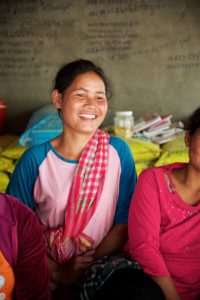
Preventing Trafficking, Keeping Children Safe in Cambodia Part 2/3
by Billie Loewen Comment
Garment production is booming in Cambodia.
Part two of three
Nearly 80 percent of Cambodia’s exports are textiles — shoes, clothes, plush toys. And of the 300,000-500,000 people who work in garment factories, 91 percent are women. Garment factories dot the countryside, especially southwest of Phnom Penh’s city center, where land is cheaper. Some factories are large — huge, sprawling tin buildings with giant, industrial fans swirling overhead. Some are built campus-style, where many factories occupy the same fenced-in space, with security controlling traffic through a front gate.
Garment factories, while often a symbol of corporate greed and mindless consumption in the U.S., are relatively well received in Cambodia.
“Those are good paying jobs,” Kosal says simply.
Minimum wage standards dictate that garment factory employees should earn at least $139 per month, but it’s likely that many are paid less. Still, in comparison to the monthly income expected from farming, making more than $100 per month is considerable. Many subsistence farmers live on less than half that amount and struggle to survive on incomes of $30-60 per month.
For Yai, working in the factories meant she missed her children, her husband and her village constantly. The work was hard and tiring, and after all the costs associated with living far from home, she wasn’t making that much more money. But economic opportunities at home were scarce, and she didn’t have any skills.
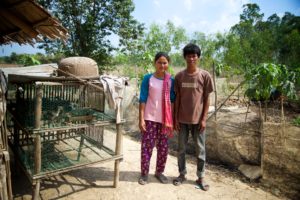
It’s families like Yai’s that prompted Holt to start programs in the region in 2013 — addressing issues of financial instability, and the myriad ways poverty impacts the security of children, including the possibility of child abandonment or exploitation.
Too many Cambodian children, we learned, were living outside or without their family due to migration. At best, children would fall behind in their education. At worst, children living apart from their families were vulnerable to abuse, hunger, child labor or trafficking.
To keep children with their families, in school and safe, Holt needed to help parents generate income, and help women, in particular, earn better income. Our on-the-ground partners from Children and Life Association (CLA), a non-profit group working to end child abuse and exploitation in the province, identified 90 of the most vulnerable families and 200 children from six villages in Prey Veng to begin receiving support through child sponsorship in 2015. To help generate income, Holt and CLA worked with these villages to form women’s self-help groups, where mothers or grandmothers enrolled in Holt’s programs meet monthly to discuss common problems, encourage one another, begin a community savings and loan fund and learn income-generating skills, such as raising livestock. Holt donors provided the funds so families could begin taking low-interest loans to purchase farm animals for income or to cover medical expenses or pay off high-interest debt to loan sharks. On a community level, Holt and CLA organized peer-led education groups, where older students help teach younger children about children’s rights, how to spot and report abuse, and how to identify a scam intended to coerce a child into being trafficked. Sponsored children also receive additional educational support.
For Yai, Holt’s work in the region offered a chance to stay home with her children — and learn valuable skills from other mothers in her community.
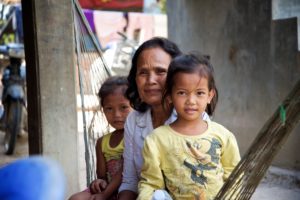
The road to Yai’s village starts wide and smooth, but gradually turns to a narrow, dusty single lane marked by bumps and potholes. Children in school uniforms travel along the side of the road in small packs. Women rest in the shady space under their homes, waiting for the heat to dissipate before they return to work. This area is one of the poorest districts in Cambodia, and nearly 15 percent of families don’t own any land, even though everyone in the community relies almost exclusively on land to generate income — whether working their own plots, or plots owned by others. Malnutrition and hunger-related illness is common here, so besides teaching and investing in family-based sustainable agriculture, CLA also teaches children and families about sanitation and hygiene and how to ensure children receive proper nutrition.
Yai’s home is about a quarter of a mile off the main road, just across from the village chief’s home where the 33 women involved in the women’s self-help group meet monthly to share information and wisdom about raising children, farming practices and saving money. The women also have the opportunity to attend special training courses to improve their skills or better care for their children. And, thanks to those new skills, Yai’s house has a few new elements. An array of bamboo and thatch cages surrounded by rough chain-link and chicken wire fences provide safety to one of the family’s greatest assets — their bank account, by all measures — of 18 hens, lots of baby chickens and about 20 ducks. She purchased her first hens and ducks with money she borrowed from the Holt-supported women’s self-help group, and CLA staff helped teach her how to raise them. Yai and her husband also have a small, man-made pond where they keep live fish, as well as a small vegetable garden, both of which provide additional food for their children.
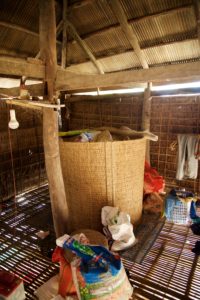
Yai can sell full-grown chickens for about $5-7 each, making a total of around $50 per month. And she can generate similar income from ducks. This is a considerable income boost for her family, especially for this area.
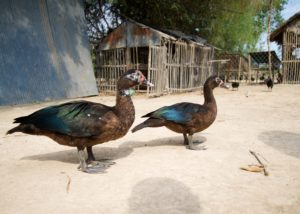
One of CLA’s two community development officers who works with Holt-sponsored families is Loan Leang, who grew up in a farming family in this same area. After high school, he received training from Veterinarians Without Borders, learning practical skills to improve animal raising in Cambodian villages. Now, he teaches women how to vaccinate their own baby chicks, or provide basic medical care to pigs and cows. By empowering families with the skills to care for their animals, Loan provides an invaluable service to poor families — one that helps them avoid the financial hardship caused when an animal dies.
photo credit: source
Disclaimer: Articles featured on Oregon Report are the creation, responsibility and opinion of the authoring individual or organization which is featured at the top of every article.


